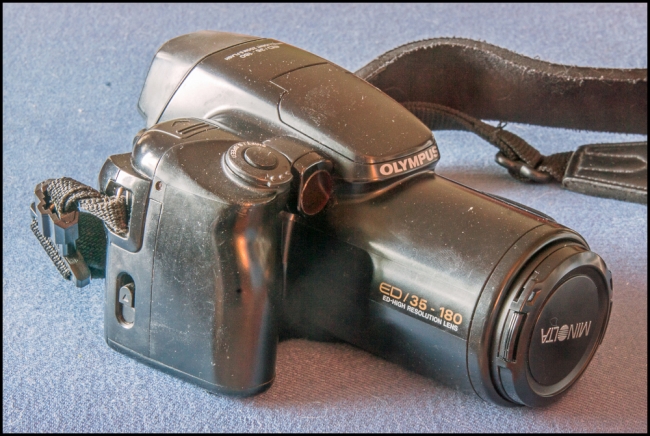I recently picked up this camera for next to nothing (the film and the processing cost significantly more than the camera did). It’s an Olympus IS-3 (also known as IS-3000 in Europe and L-3000 in Japan) and it came out in 1992. I was interested in it because it’s a bit out of the ordinary (as an early attempt at a bridge camera) and was reputed to have an excellent lens.
Cosmetically it’s not in the greatest shape, but everything seems to work as it should (we’ll see). The only problem I’ve noticed is an LCD bleed in the viewfinder. It’s still just about usable (except in really bright light) and in any case I can always take a quick look at the large rear LCD screen if I need to so it’s not all that much of a problem.
This particular camera features the date back (which I’ll never use) and is called the IS-3 DLX QD.
It has a 35-180mm f4.5-5.6 lens comprising 16 elements in 15 groups focusing down to 1.2 meters (0.6m in macro mode).
Shutter speeds range from 15 seconds to 1/2000 second plus ‘B’. Manual shutter speed range at F8: 60 sec.~1 sec.; Programmed shutter speed range: 4 sec.~1/2000 sec. Flash synch is 1/100 second.
Focus modes include Single Auto Focus; Continuous Auto Focus, and Power Focus (manual focus).
The viewfinder (85% coverage) includes: the following information: Autofocus Frame; Spot Frame; Panorama Marks; Autofocus Indicator; Shutter Speed; Aperture Setting; Spot Metering; Macro Mode; Exposure Compensation / Manual Exposure; Flash Symbol.
Exposure consists of a TTL light metering system with fuzzy logic ESP light metering including center-weighted average light metering and spot metering (don’t ask me what that last sentence means). Exposure compensation is in the range of +/- 4ev in 1/3rd step increments. ISO is determined by DX coding in the range of ISO 25-5000. The following exposure modes are supported: Aperture Preferred AE; Shutter Preferred AE; Manual Exposure; Program; Sport Program (Stop Action); Portrait Program; Landscape Program; Night Program.
The camera has a built in flash with guide number of 28 (auto tele) or 20 (auto wide, manual). A dedicated flash unit (G40) was also available.
Power comes from two 3V lithium batteries (CR 123A or DL 123A).
It’s a solid feeling camera weighing 960 g. with the following dimensions (width, height, depth): 112x93x173mm.
Wide angle, tele and macro converters were also available.
For an overview of of the series see: Olympus IS-Series, which is complete up to this model.

